RETROVIRIDAE
Non-segmented, enveloped, ss, (+), RT viruses
General Characteristics
- Retroviruses do not follow the central thesis of biology, which maintains that the direction of flow of information and function is from DNA to RNA.
- The enzyme reverse transcriptase (RT) is packed in the virus.
- First viruses shown to cause cancer and have been studied more extensively for their carcinogenic characteristics.
- Not all retroviruses cause cancer, but tumorigenic retroviruses (sarcomas) are quite common.
- It seems that they possess a transforming gene (viral oncogene) that brings about cellular transformation.
- Virus genome can become integrated into host genome by way of the DNA intermediate.
- Process studied as a means of introducing foreign genes into a host (gene therapy).
- Retroviruses were the first viruses to be modified for gene therapy, and continue to be used in the majority of gene therapy clinical trials.
- Have properties similar to those of DNA and RNA viruses.
- They resemble movable genetic elements and are sometimes considered to be escaped cellular transposable elements.
- They resemble bacterial viruses such as Mu.
Taxonomy
Retroviruses are currently classified into 2 Subfamilies and 7 genera.
Family: Retroviridae
Subfamily: Orthoretrovirinidae
Genera
Alpharetrovirus
Rous sarcoma virus
Avian viruses
Betaretrovirus
Mammal viruses
Gammaretrovirus
Mammal viruses
Deltaretrovirus
Human B- or adult T-cell leukemia/lymphoma, HTLV.
Primate lymphotrophic viruses
Bovine leukemia virus
Epsilonretrovirus
Dermal, epidermal and hyperplasia viruses
Lentivirus (HIV) (L., lenti = slow)
Human immunodeficiency viruses (HIV 1&2)
Bovine, caprine, feline, equine, puma, simian and Visna immunodeficiency viruses
Subfamily: Orthoretrospumavirinae
Genus
Spumavirus
African green monkey, bovine, equine, feline, macaque simian and simian foamy viruses.
Structure
- Virions consist of an envelope, a nucleocapsid, and a nucleoid.
- Particle diameter ranges between 80-100 nm.
- The icosahedral nucleoid is concentric or eccentric while the core is spherical.
- Retroviruses have a lipid envelope bilayer with surface proteins.
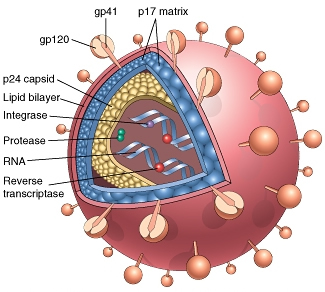 ......
......
Source:ICTV Source: Elsevier
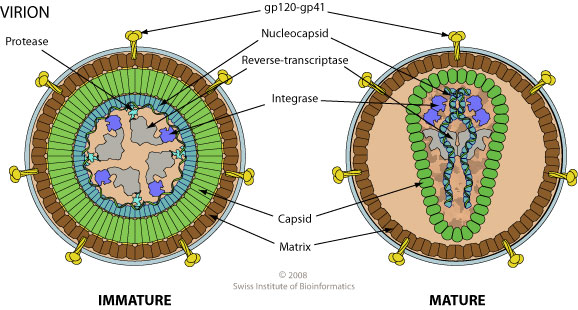
Source: Swiss Institute of Bioinformatics.
Genome
Notes on the Diploid Condition
- Differ from other viruses in having a diploid genome (dimeric).
- Genome consists of two identical RNA molecules joined together by
H bonds.
- The reason for this feature is not clearly understood.
- It appears probable that the interaction of the two molecules serves as a regulatory function in reverse transcription.
- Duplication may also permit a higher rate of recombination, particularly if heterozygotes form in which each RNA molecule within a virion core comes from a different virus.
Notes on Reverse Transcriptase (RT)

- Discovered by David Baltimore and Howard Temin (MIT) in 1970 shattering the so-called 'central dogma' of biology.
- Retrovirions contain approximately 50-100 molecules of RT (an RNA-dependent RNAP).
- Also in the hepatitis B virus (Hepadnaviridae - ds/ss DNA) and in the cauliflower mosaic virus (Caulimovirus -ss DNA).
- Only in retroviruses the intermediate DNA is incorporated into the
host genome as a provirus.
- RT shows four enzymatic activities:
- Synthesis of DNA with an RNA template (reverse transcription).
- Synthesis of DNA with a DNA template.
- Ribonuclease H activity (an activity that degrades the RNA strand of an RNA:DNA hybrid).
- A DNA-unwinding activity (helicase-like).
- Like all DNAPs, RT needs a primer for DNA synthesis.
- Primer molecule (usually a polynucleotide) to which DNAP attaches the first nucleotide during DNA replication.
- The primer for retrovirus reverse transcription is a specific cellular transfer (tRNA).
- DNA synthesis from RNA commences with the tRNA primer at the 5' terminus
of the virion RNA.
- Remember that nucleic acid synthesis always proceeds from the 3' to the 5' terminus of the template.
- The type of tRNA used as primer depends on the virus and is brought into the virion from the previous host cell.
- In the case of the Rous sarcoma virus, the tRNA used is the tryptophan tRNA.
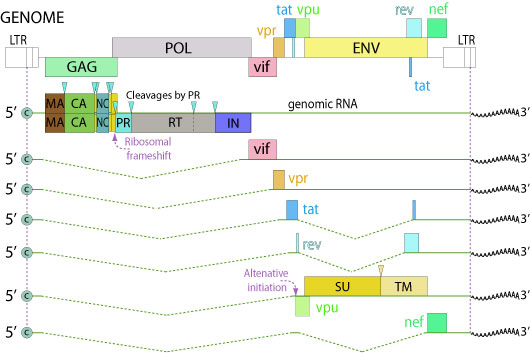
Structure of the Genome
- The genome of retroviruses is unique.
- Consists of two identical ssRNA molecules of plus complementarity, each 7-11 kb in length.
- The 5'-end of the genome has a methylated nucleotide cap with a cap sequence type 1 m7G5ppp5'GmpNp.
- The 3'-terminus of each monomer has a poly (A) tract and the terminus has a tRNA-like structure.
- There are also a primer binding site (PBS) at the 5’end and a polypurine tract (PPT) at the 3’end.
- RNA is capable of acting directly as an mRNA but is not used as such.
- There are two long terminal repeats (LTRs) of about 600nt long at the 5’ and 3’ ends.
- The LTRs contain the U3, R, and U5 regions.
- Seven internal proteins, 4 of which are structural and 3 enzymatic {RT, DNA endonuclease (integrase), and a protease}.
- The genetic map includes the following regions and in the same order:
- gag - encoding internal structural proteins.
- pol - encoding RT and integrase.
- env - encoding envelope proteins.
- The Rous sarcoma virus carries a fourth gene located downstream from env and is involved in cellular transformation and cancer.
Replication
- GP120 attaches to the CD4 receptors and a chemokine coreceptor [CCR-5 (fusin)] on the cell membrane of T-helper cells.
- Internalization and integration of the DNA copy into the host genome.
- Integration is not required for retrovirus multiplication (although under natural conditions the virus always integrates).
- RT of one of the two RNA genomes into a ssDNA that is subsequently converted to a linear dsRNA by RT.
- Transcription of the viral DNA, leading to the formation of viral mRNAs and progeny viral RNA.
- A fraction of these new RNAs are spliced to allow expression of some genes, while others are left as full-length RNAs.
- Viral proteins are synthesized by the host cell's translational machinery.
- Assembly of the virion at the host cellular membrane and packaging of the viral RNA genome into the capsid in the cytoplasm.
- Budding of enveloped virions at the cytoplasmic membrane and release from the cell.
- The rate of virus production from the cell is slow and cells continue to divide.
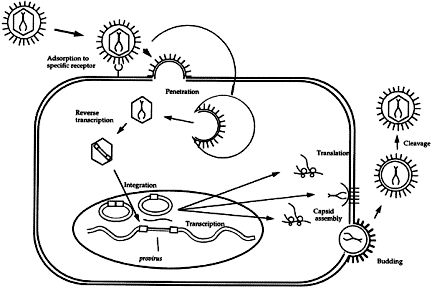
Source: via Standford University
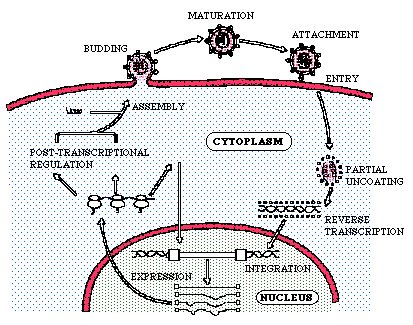
Source: Microbiology bytes
Diseases
Human Pathogenic Retroviruses
HIV (Human immunodeficiency virus)
HTLV (Human T-cell leukemia virus) I and I
Discovered in the southern islands of Japan
HTLV II infects human CD8+ cells
Intravenous drug users
Diseases in Birds and Mammals
Rous sarcoma virus
In chickens -- (sarcomas are malignant tumors of connective tissue, bone, cartilage, or muscle)
Murine sarcoma virus
Simian T-cell leukemia virus
Simian immunodeficiency virus
Cause AIDS in certain monkeys but not in others
Bovine leukemia virus
Equine, bovine and feline lentiviruses
